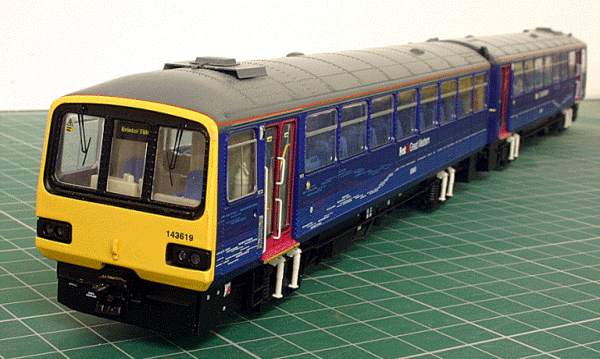Steve Johnson Modelmaker
|
|
Class 143
Pacer, Barclay-Alexander
Built by Hunslet-Barclay at their Kilmarnock works, this version of a 4 wheel lightweight unit is based on a Walter Alexander bus body. They entered service in 1985 in the North East, but have all ended up in the South West with First Great Western. Realtrack Models, based in Leeds, make an absolutely fabulous model of the Class 143 (and 144) in a variety of liveries. The level of detail is stunning for such a small train and is a credit to the manufacturers. My model is of 143 619 in First Great Western 'Local Lines' livery. The livery application is first class and all the place names on the bodysides are readable with a magnifying glass. Only one car is powered and features a simple suspension system to assist wheel/rail contact on the four wheel chassis. A clever 8 pin coupling is used to transfer track pick ups and lighting functions to and from the unmotored car. Performance is good and has now been fitted with a DCC chip. It seems almost churlish to criticise such a good model, but there are a few down points. The lighting is only suitable for daytime running. Both headlight and marker lights seem to be the same brightness, whereas the marker should be dimmer. Fitting the DCC chip is a very fiddly business and there is a great danger of damaging the model. Realtrack do offer a fitting service and I would recommend that this is taken up if you are unsure. However, I did it myself and used the recommended (by Realtrack) Lenz Standard decoder. Apparently there have been running issues with other types of chip, so I chose to stick with Lenz. The decoder fits in the un-motored car and the body unclips, with three clips on each side. The cast seating block has to come out which is held in by two crosshead screws in the floor. By careful manipulation, the seating block will come out with the lighting bar sliding out from the drivers end. There is a piece of white insulating material over the DCC socket and when this is removed, two sprung metal clips are visible. Remove these and plug in the decoder. The Lenz Standard neatly fits in a slot in the moulding with the wires running through rebates under the decoder. As the seating block is cast metal, a strip of insulating tape across the decoder will prevent any shorts. Having run the unit to make sure everything worked, the car was reassembled, carefully! Above each of the axle blocks are two springs, which fell out and needed to be put back in place. There is also plenty of room for a sound decoder and speaker, with the floor thoughtfully being provided with holes to let the sound out! The model is fitted with miniature Bachmann style tension lock couplers, but a set of Scharfenburg couplers is included as an alternative. All in all, an excellent model and extremely reasonably priced for what you get!
|
